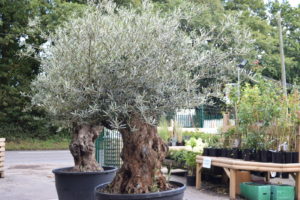

Olive Tree
Olives (Olea europaea) are evergreen trees that will add a Mediterranean touch to the garden. They are suited to garden or container cultivation, and may produce fruit in mild regions and warm summers in the UK.
Common name: Olive
Botanical name: Olea europaea
Group: Tree
Flowering Time: Summer
Planting time: Spring
Height and spread: Up to 10m (30ft) height and spread
Aspect: South- or west-facing, sheltered
Hardiness: Frost hardy
Difficulty: Moderate
Cultivation notes
If you have a protected city garden or live in a mild area, olives can be grown outdoors as long as you give them a sunny position and plant them in well-drained soil, for example, against a warm wall would be ideal. IN cold or northern regions winter protection in a conservatory for example, will be required.
Once established they are extremely drought-tolerant, but plants will do better if watered regularly in dry spells during the growing seasons. To encourage strong growth, it’s a good idea to feed each spring with a general fertiliser, such as Vitax Q4.
Olives naturally shed their older leaves in spring (April in the UK) as new growth begins.
Pruning and training
Olives grow very slowly, so don’t require much pruning at all. If needed, in late spring or early summer, remove dead, diseased or dying branches. At the same time, thin out branches to allow light into the centre of the tree and remove any branches that spoil the shape. Avoid pruning too hard as this will result in the over-production of non-fruiting water shoots.
Container-grown plants may need additional summer pruning to keep their size in check. When plants in containers get to about 1.5m (5ft), pinch out the tips to encourage branching.
Problems
Poorly-drained soil conditions can lead to root disease such as Verticillium wilt or Phytopthora root rot. Honey fungus may cause plant death.




